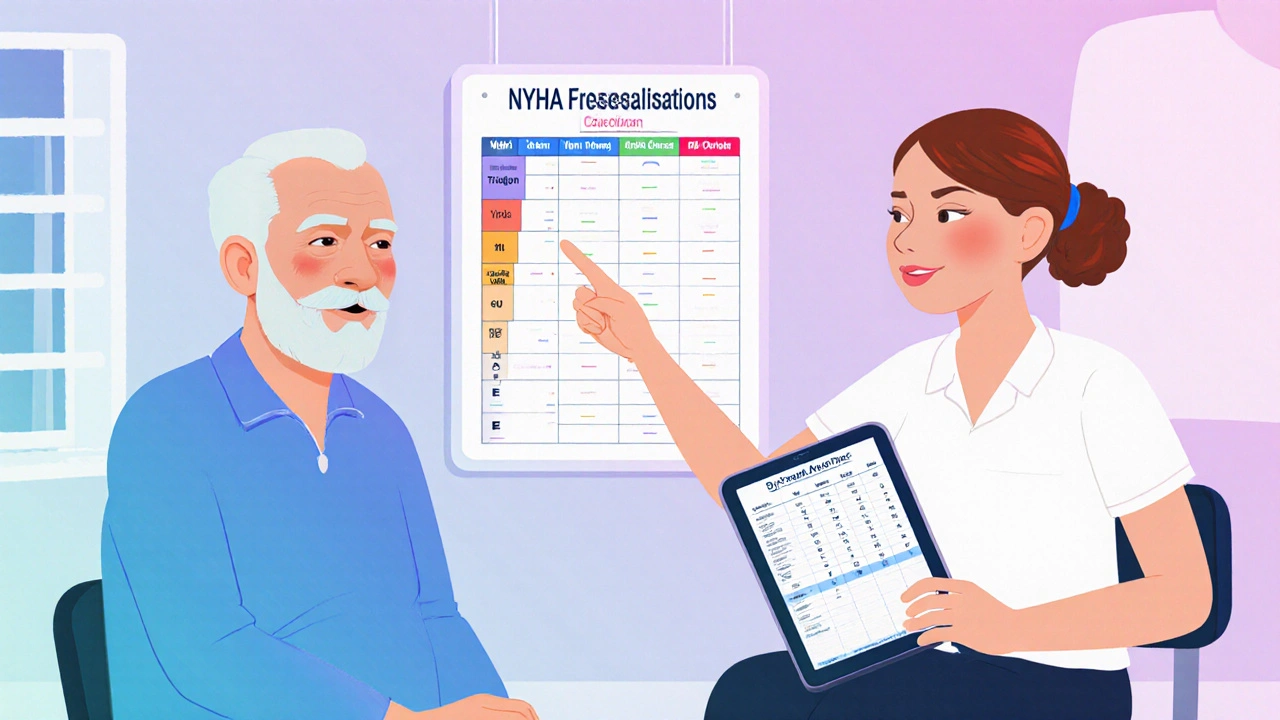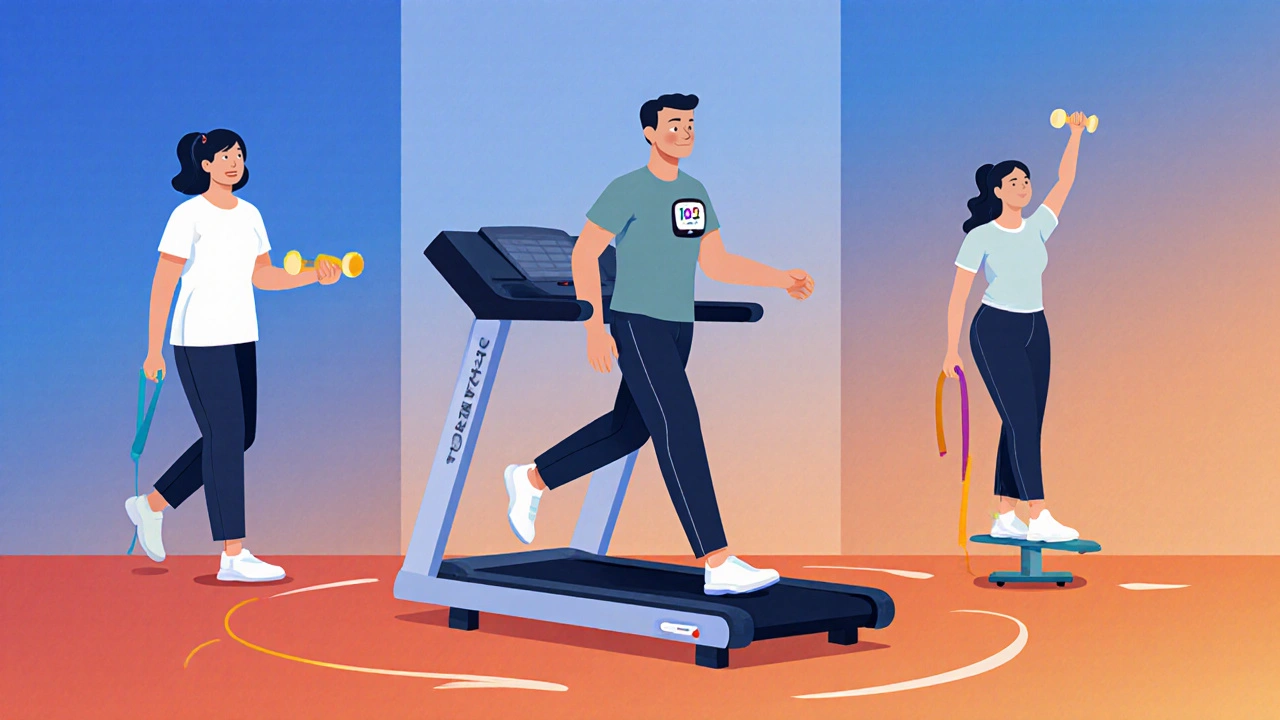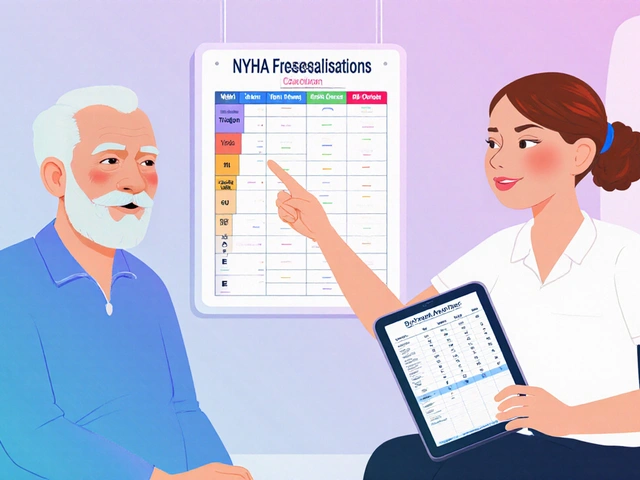Physical Therapy for Chronic Heart Failure: Benefits, Techniques & Outcomes

Physical Therapy Prescription Calculator
Personalized Exercise Prescription
Enter your clinical data to receive safe exercise recommendations based on evidence-based guidelines for chronic heart failure.
When managing Chronic Heart Failure is a progressive condition where the heart cannot pump enough blood to meet the body’s needs, Physical Therapy plays a pivotal role in slowing decline and improving daily life.
Why Physical Therapy Matters in Heart Failure Care
Patients with chronic heart failure (CHF) often experience fatigue, shortness of breath, and reduced exercise capacity. Traditional medical therapy controls fluid balance and neuro‑hormonal activation, but it does little for the de‑conditioning that makes everyday tasks feel impossible. Physical therapy bridges that gap by:
- Improving cardiovascular efficiency through tailored aerobic training.
- Strengthening peripheral muscles to reduce the heart’s workload.
- Enhancing balance and coordination, which cuts fall risk.
- Providing education on symptom monitoring and self‑management.
These benefits translate into measurable outcomes such as lower NYHA functional class, higher 6‑Minute Walk Test distances, and fewer hospital readmissions.
Key Assessment Tools Used by Therapists
Before any program starts, a therapist conducts a comprehensive evaluation. The most common tools are:
- NYHA Functional Classification - grades symptoms from I (no limitation) to IV (severe limitation). It guides exercise intensity.
- 6‑Minute Walk Test (6MWT) - measures how far a patient can walk in six minutes, providing a baseline for progress.
- Ejection Fraction (EF) - obtained from echocardiography, it helps set safe workload thresholds.
- Blood pressure and heart rate response during sub‑maximal exertion.
Data from these assessments feed directly into an individualized Exercise Prescription.
Designing the Exercise Prescription
Physical therapy programs typically combine three pillars:
- Aerobic training - walking, stationary cycling, or low‑impact pool exercises. Sessions start at 40‑50% of peak VO₂ and progress by 5‑10% each week.
- Resistance training - 2-3 sets of 8-12 repetitions using light weights or resistance bands. Target major muscle groups, especially quadriceps and gluteals, which are crucial for walking.
- Flexibility and balance work - static stretches and proprioceptive drills to reduce fall risk.
Frequency is usually 3-5 days per week, with each session lasting 30-60 minutes. Therapists monitor Borg’s Rating of Perceived Exertion, aiming for a score of 11-13 (light to moderate).
Evidence Supporting Physical Therapy in CHF
Multiple randomized controlled trials and meta‑analyses have quantified the impact of structured exercise on heart failure outcomes. Highlights include:
- A 2022 meta‑analysis of 28 trials (n≈3,200) reported a mean increase of 45 meters in the 6MWT after 12 weeks of supervised aerobic training.
- Patients adhering to combined aerobic‑resistance programs showed a 19% reduction in all‑cause hospital readmission over 12 months.
- Quality‑of‑Life scores (Kansas City Cardiomyopathy Questionnaire) improved by an average of 12 points, surpassing the minimal clinically important difference.
These data underscore that physical therapy is not an optional add‑on but a core component of modern heart failure management.
Comparison of Standard Care vs. Physical‑Therapy‑Enhanced Care
| Outcome | Standard Care | Medical + Physical Therapy |
|---|---|---|
| 6‑Minute Walk Distance (Δ meters) | +12 ± 8 | +45 ± 10 |
| Hospital Readmissions (12 mo) | 22 % | 17 % |
| NYHA Class Improvement | 0.3 ± 0.2 | 0.8 ± 0.3 |
| Quality‑of‑Life Score ↑ | 5 ± 3 | 12 ± 4 |
The table illustrates that adding physical therapy yields clinically significant gains across all measured domains.

Practical Tips for Patients and Clinicians
Even with strong evidence, real‑world implementation can stumble. Here are actionable pointers:
- Start low, progress gradually. A 5‑minute walk on day 1 can bloom into a 30‑minute brisk walk by week 6.
- Monitor symptoms. Sudden dyspnea, chest pain, or new palpitations require immediate medical review.
- Use wearable trackers. Heart‑rate monitors help keep intensity within prescribed zones.
- Integrate home‑based sessions. After 2-3 supervised weeks, patients can safely continue exercises at home, boosting adherence.
- Coordinate with the cardiology team. Regular updates on EF, medication changes, and any arrhythmias ensure the program stays safe.
Potential Barriers and How to Overcome Them
Common obstacles include limited access to cardiac rehab facilities, fear of exertion, and comorbidities such as arthritis. Strategies:
- Tele‑rehab platforms allow remote supervision via video calls. \n
- Low‑impact modalities (e.g., seated cycling, aquatic therapy) accommodate joint pain.
- Motivational interviewing techniques help patients reframe exercise as “medicine” rather than a chore.
Future Directions: Integrating Technology and Personalized Medicine
Emerging tools promise to refine physical therapy for CHF even further:
- Wearable ECG patches provide real‑time rhythm monitoring, allowing therapists to tweak intensity on the fly.
- AI‑driven analytics can predict which patients will respond best to resistance training versus pure aerobic work.
- Genetic profiling may someday inform individualized exercise prescriptions based on metabolic pathways.
While these innovations are still emerging, they signal a future where physical therapy becomes even more precise and potent.
Bottom Line
Physical therapy transforms chronic heart failure from a relentlessly progressive condition into a manageable, even improvable, health state. By systematically assessing function, prescribing targeted aerobic and resistance exercises, and monitoring progress, therapists cut hospital stays, boost quality of life, and give patients real control over their hearts.

Can I start a physical therapy program without a doctor’s referral?
In many health systems, a formal referral is required for insurance coverage, but self‑initiated programs are possible if you discuss the plan with your cardiologist first. They can confirm safety parameters such as EF and blood pressure limits.
How often should I exercise if I have NYHA class III heart failure?
Guidelines recommend 3-5 sessions per week, each lasting 30-45 minutes, at an intensity that keeps the Borg rating around 11-13. Start with short intervals and build up as tolerated.
Is resistance training safe for heart failure patients?
Yes. Light‑to‑moderate resistance work improves muscle strength without overloading the heart, provided the load stays below 50% of one‑rep max and vital signs are monitored.
What improvements can I expect in the 6‑Minute Walk Test?
Most studies report an increase of 30-50 meters after 12 weeks of supervised training, which correlates with better daily function and lower mortality risk.
Do I need special equipment for home‑based cardiac rehab?
A simple step platform, a set of resistance bands, and a heart‑rate monitor are usually enough. Many clinics provide tele‑rehab kits that include instructional videos and remote oversight.


Eli Soler Caralt
In the grand tapestry of human fragility, the beating heart is perhaps the most poetic metronome, yet it is not immune to the erosion of time 😏. Physical therapy, when wielded with scholarly precision, operates as a symphonic conductor that re‑orchestrates the failing myocardium's rhythm. By engaging the peripheral musculature, we effectively redistribute hemodynamic load, a principle that the ancients might have called “balance of the humors”. The aerobic prescriptions outlined-40‑50% peak VO₂-are not arbitrary numbers but reflections of the sigmoid curve that governs oxygen uptake kinetics. Moreover, the incremental 5‑10% weekly progression mirrors the mathematical elegance of geometric series, ensuring adaptation without catastrophic decompensation. When therapists incorporate Borg’s RPE of 11‑13, they are subtly harnessing psychophysiological feedback loops that optimize autonomic tone. Resistance training, especially targeting the quadriceps, furnishes a mechanical lever that reduces afterload, whilst also enhancing venous return via the muscle pump. Flexibility and proprioception drills, though often dismissed as “nice‑to‑have”, are in fact crucial for mitigating fall risk, a leading cause of morbidity in NYHA class III‑IV. The evidence, as you cited, demonstrates a 45‑meter augmentation in the 6‑Minute Walk Test-a clinically meaningful stride toward independence. One must also acknowledge the psychosocial uplift; patients report a rejuvenated sense of agency, an existential rebirth that textbooks seldom quantify. In an era where tele‑rehab platforms proliferate, the convergence of wearable ECG patches with AI‑driven analytics portends a future where therapy is individualized to an almost alchemical degree. Yet, we must remain vigilant: the allure of technology must not eclipse the foundational clinician‑patient rapport, the very crucible of therapeutic success. Ultimately, the integration of physical therapy into CHF management is less a supplemental garnish and more the main course of modern cardiology 🍽️. Let us, therefore, champion its widespread adoption, lest we consign countless hearts to a fate of gradual surrender. Such holistic stewardship aligns with the Hippocratic oath to do no harm and to promote healing.
Eryn Wells
Physical therapy isn’t just a set of exercises; it’s an invitation to reclaim autonomy over one’s own body 🌟. By teaching patients to monitor Borg scores and adjust intensity, therapists empower them to become active participants in their care. The balanced blend of aerobic, resistance, and balance work respects the holistic nature of health, honoring both the mechanical and emotional dimensions. Moreover, when clinicians coordinate with cardiology, they create a safety net that catches any sudden decompensation. This collaborative model exemplifies true patient‑centered care and should be the gold standard. 🙌
Kathrynne Krause
Wow, Eli, that poetic framing really hit home-your 15‑sentence symphony makes the science feel almost lyrical. I especially love how you tied the muscle pump to afterload reduction; many overlook that subtle hemodynamic dance. Your nod to AI‑driven analytics feels spot‑on, reminding us that tech should augment, not replace, the therapist’s intuition. The reminder about preserving the clinician‑patient rapport is a crucial grounding point, lest we become slaves to data alone. Thanks for weaving philosophy with hard‑core evidence; it’s a refreshing palate cleanser in a sea of bland summaries.
erica fenty
When constructing an exercise regimen for CHF patients, aerobic conditioning, resistance training, and flexibility work must be integrated,, the intensity should be calibrated to 40‑50% of peak VO₂,, progression should follow a 5‑10% weekly increase,, Borg RPE targets of 11‑13 are essential,, monitoring vitals is non‑negotiable,, and adherence can be bolstered through tele‑rehab platforms,,
Xavier Lusky
They’re hiding the truth about how “rehab” profits the industry.
Ashok Kumar
Sure, just add a few banded squats and a walk around the block, and your heart will miraculously start pumping like a brand‑new engine. No need for meds or follow‑ups, right?
Jasmina Redzepovic
Listen, the data is crystal clear-resistance training under proper supervision reduces morbidity by up to 19 % and improves EF modestly. Anyone who says otherwise is ignoring peer‑reviewed meta‑analyses and flaunting ignorance. In the United States, cardiac rehab is a national priority, and dismissing it as “just a walk” is not only naïve but also dangerous. If you want real outcomes, you must adopt the evidence‑based protocols, period.
parbat parbatzapada
i cant even begin to explain how much i was scared to even think about moving my body after that heart scare 😱. but then i saw a therapist and she made it feel like i was dancing, not dying. low‑impact pool sessions became my sanctuary, and the weird echo of my own breath turned into a mantra. sure, the pain in my knees sometimes shows up, but i push through because every splash feels like a victory over the darkness. i swear the whole thing feels like a movie, and i’m the hero finally getting back on his feet.
Casey Cloud
First you get a baseline 6MWT then you set a realistic goal aim for a 5‑10% increase each month keep the intensity at a Borg 11‑13 watch heart rate and blood pressure and adjust as needed the program should include three days of aerobic work two days of light resistance and one day of balance drills consistency is key you’ll see improvements in functional capacity and quality of life
Rachel Valderrama
Wow Casey, thanks for the novella of “keep it simple.” 🙄 If I wanted a poetry slam about walking, I’d ask a poet, not a therapist. But hey, at least we have a checklist now-maybe next you’ll write an opera about heart rate zones.
Brandy Eichberger
Dear colleagues, allow me to commend the thoroughness of this discourse; the integration of biomechanics, neuro‑hormonal modulation, and patient‑centred education truly elevates the standards of cardiac rehabilitation. Your collective insights are a testament to the intellectual rigor that our profession demands, and I am delighted to be part of such an erudite community. 😊
Chirag Muthoo
Thank you for your gracious remarks, Ms. Eichberger. I concur that the multidisciplinary approach delineated herein reflects the highest echelons of clinical practice. It is incumbent upon us to perpetuate this level of scholarly exchange to foster continued advancement in the management of chronic heart failure.